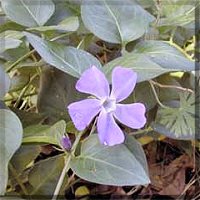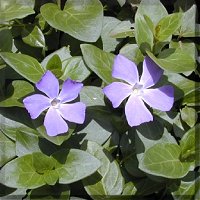

Vinca major


Vinca major
Common Names - bigleaf periwinkle, greater periwinkle
Description - Periwinkle is a fast growing herbaceous perennial groundcover with evergreen foliage and pretty blue flowers. The arching stems of big periwinkle can reach about 12 in (30 cm) in height, but they soon fall over and spread indefinitely, rooting at the nodes as they cover the ground with shiny dark green foliage. The leaves are in pairs opposite each other along the stems; they are 2-3 in (5-8 cm) long and oval or heart shaped. The flowers are borne singly in the leaf axils on ascending stems. They are blue-violet, funnel shaped with five petals and about 2 in (5 cm) across. Big periwinkle flowers profusely all spring and sporadically throughout the summer. Two subspecies occur in the wild: hirsuta has numerous hairs on the stems and petioles and has lance shaped leaves; major is less pubescent, with leaves as described for the species. The cultivar 'Alba' has white flowers. 'Oxyloba' has deep purple flowers. There are several cultivars selected for their variegated foliage. Originating in northern Spain, western France, and central and southern Europe, this familiar ground-hugging evergreen shrub can now be found throughout the world. Its purplish-blue flowers won it the name "Sorcerer's Violet" in the Middle Ages. It was placed on the coffins of dead children in years gone by. In German, it's therefore called the "Flower of Immortality" and in Italian the "Flower of Death."
Parts used - Leaves and rootsPharmacology - Indole alkaloids - pervincamine (indole alkaloid), vincamine (indole alkaloid), tannins.
Medicinal uses - The original use of the plant goes back to European traditional home remedies for cerebrovascular disorders and related symptoms. Its alkaloids are Hypotensive, sedative and have tranquilizing properties and are anti cancerous. It helps in relieving muscle pain, depression of central nervous system and wasps’ stings. Periwinkle has also been employed for many years in the treatment of diabetes. Periwinkle is an excellent all-round astringent that may be used internally or externally. Its main use is in the treatment of excessive menstrual flow, either during the period itself (menorrhagia) or with blood loss between periods (metrorrhagia). As with other remedies that effect the uterus, it can be used to address similar processes in the urinary system. Thus it can be used for cases hematuria. Also used in digestive problems such as colitis or diarrhea where it will act to reduce the loss of fluid or blood whilst toning the membranes. May be used in cases of nose bleed, bleeding gums, mouth ulcers or sore throats. For toothaches, the herb can be chewed.
In 1999, the FDA approved Vinpocetine which is a derivative of the periwinkle plant for use as a dietary supplement. Today, Vinpocetine is most often used as a cerebral vasodilator to increase blood flow to the brain, improve its oxygenation thereby increasing mental alertness and acuity. Dosage:Combinations : It combines well with Cranesbill and Agrimony. For menstrual problems it may be used with Beth Root.
Contraindications and toxity - lowers blood pressure. Periwinkle is not known to be harmful when taken in recommended dosages, though it is important to remember that the long-term effects of taking the herb (in any amount) have not been investigated. Periwinkle should not be used by people with low blood pressure or constipation. Due to lack of sufficient medical study, periwinkle should be used with caution in children, women who are pregnant or breast-feeding, and people with liver or kidney disease. Taking too much periwinkle can cause a potentially dangerous drop in blood pressure (symptoms include dizziness and fainting). In case of overdose, seek emergency care. Periwinkle may cause flushing and gastrointestinal problems.